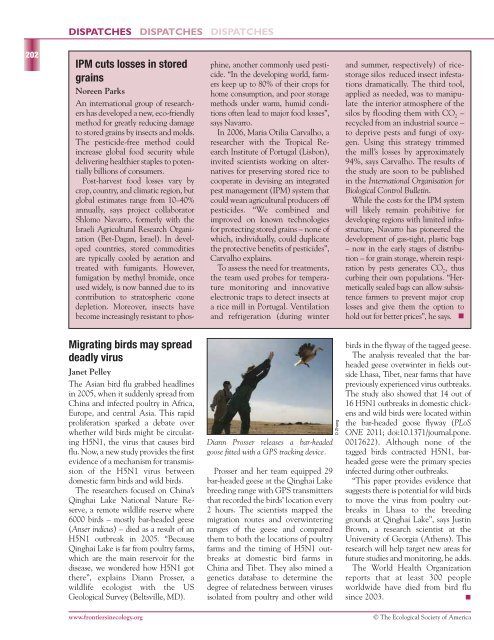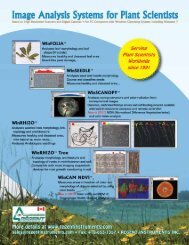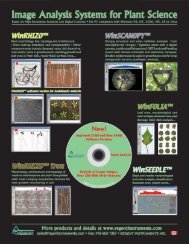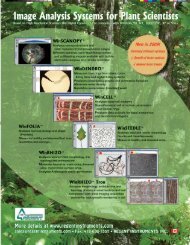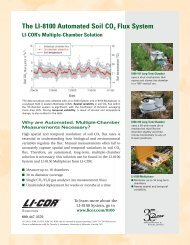Dispatches - Frontiers in Ecology and the Environment
Dispatches - Frontiers in Ecology and the Environment
Dispatches - Frontiers in Ecology and the Environment
You also want an ePaper? Increase the reach of your titles
YUMPU automatically turns print PDFs into web optimized ePapers that Google loves.
DISPATCHES DISPATCHES<br />
DISPATCHES<br />
202<br />
IPM cuts losses <strong>in</strong> stored<br />
gra<strong>in</strong>s<br />
Noreen Parks<br />
An <strong>in</strong>ternational group of researchers<br />
has developed a new, eco-friendly<br />
method for greatly reduc<strong>in</strong>g damage<br />
to stored gra<strong>in</strong>s by <strong>in</strong>sects <strong>and</strong> molds.<br />
The pesticide-free method could<br />
<strong>in</strong>crease global food security while<br />
deliver<strong>in</strong>g healthier staples to potentially<br />
billions of consumers.<br />
Post-harvest food losses vary by<br />
crop, country, <strong>and</strong> climatic region, but<br />
global estimates range from 10–40%<br />
annually, says project collaborator<br />
Shlomo Navarro, formerly with <strong>the</strong><br />
Israeli Agricultural Research Organization<br />
(Bet-Dagan, Israel). In developed<br />
countries, stored commodities<br />
are typically cooled by aeration <strong>and</strong><br />
treated with fumigants. However,<br />
fumigation by methyl bromide, once<br />
used widely, is now banned due to its<br />
contribution to stratospheric ozone<br />
depletion. Moreover, <strong>in</strong>sects have<br />
become <strong>in</strong>creas<strong>in</strong>gly resistant to phosph<strong>in</strong>e,<br />
ano<strong>the</strong>r commonly used pesticide.<br />
“In <strong>the</strong> develop<strong>in</strong>g world, farmers<br />
keep up to 80% of <strong>the</strong>ir crops for<br />
home consumption, <strong>and</strong> poor storage<br />
methods under warm, humid conditions<br />
often lead to major food losses”,<br />
says Navarro.<br />
In 2006, Maria Otilia Carvalho, a<br />
researcher with <strong>the</strong> Tropical Reearch<br />
Institute of Portugal (Lisbon),<br />
<strong>in</strong>vited scientists work<strong>in</strong>g on alternatives<br />
for preserv<strong>in</strong>g stored rice to<br />
cooperate <strong>in</strong> devis<strong>in</strong>g an <strong>in</strong>tegrated<br />
pest management (IPM) system that<br />
could wean agricultural producers off<br />
pesticides. “We comb<strong>in</strong>ed <strong>and</strong><br />
improved on known technologies<br />
for protect<strong>in</strong>g stored gra<strong>in</strong>s – none of<br />
which, <strong>in</strong>dividually, could duplicate<br />
<strong>the</strong> protective benefits of pesticides”,<br />
Carvalho expla<strong>in</strong>s.<br />
To assess <strong>the</strong> need for treatments,<br />
<strong>the</strong> team used probes for temperature<br />
monitor<strong>in</strong>g <strong>and</strong> <strong>in</strong>novative<br />
electronic traps to detect <strong>in</strong>sects at<br />
a rice mill <strong>in</strong> Portugal. Ventilation<br />
<strong>and</strong> refrigeration (dur<strong>in</strong>g w<strong>in</strong>ter<br />
<strong>and</strong> summer, respectively) of ricestorage<br />
silos reduced <strong>in</strong>sect <strong>in</strong>festations<br />
dramatically. The third tool,<br />
applied as needed, was to manipulate<br />
<strong>the</strong> <strong>in</strong>terior atmosphere of <strong>the</strong><br />
silos by flood<strong>in</strong>g <strong>the</strong>m with CO 2<br />
–<br />
recycled from an <strong>in</strong>dustrial source –<br />
to deprive pests <strong>and</strong> fungi of oxygen.<br />
Us<strong>in</strong>g this strategy trimmed<br />
<strong>the</strong> mill’s losses by approximately<br />
94%, says Carvalho. The results of<br />
<strong>the</strong> study are soon to be published<br />
<strong>in</strong> <strong>the</strong> International Organisation for<br />
Biological Control Bullet<strong>in</strong>.<br />
While <strong>the</strong> costs for <strong>the</strong> IPM system<br />
will likely rema<strong>in</strong> prohibitive for<br />
develop<strong>in</strong>g regions with limited <strong>in</strong>frastructure,<br />
Navarro has pioneered <strong>the</strong><br />
development of gas-tight, plastic bags<br />
– now <strong>in</strong> <strong>the</strong> early stages of distribution<br />
– for gra<strong>in</strong> storage, where<strong>in</strong> respiration<br />
by pests generates CO 2<br />
, thus<br />
curb<strong>in</strong>g <strong>the</strong>ir own populations. “Hermetically<br />
sealed bags can allow subsistence<br />
farmers to prevent major crop<br />
losses <strong>and</strong> give <strong>the</strong>m <strong>the</strong> option to<br />
hold out for better prices”, he says. n<br />
Migrat<strong>in</strong>g birds may spread<br />
deadly virus<br />
Janet Pelley<br />
The Asian bird flu grabbed headl<strong>in</strong>es<br />
<strong>in</strong> 2005, when it suddenly spread from<br />
Ch<strong>in</strong>a <strong>and</strong> <strong>in</strong>fected poultry <strong>in</strong> Africa,<br />
Europe, <strong>and</strong> central Asia. This rapid<br />
proliferation sparked a debate over<br />
whe<strong>the</strong>r wild birds might be circulat<strong>in</strong>g<br />
H5N1, <strong>the</strong> virus that causes bird<br />
flu. Now, a new study provides <strong>the</strong> first<br />
evidence of a mechanism for transmission<br />
of <strong>the</strong> H5N1 virus between<br />
domestic farm birds <strong>and</strong> wild birds.<br />
The researchers focused on Ch<strong>in</strong>a’s<br />
Q<strong>in</strong>ghai Lake National Nature Reserve,<br />
a remote wildlife reserve where<br />
6000 birds – mostly bar-headed geese<br />
(Anser <strong>in</strong>dicus) – died as a result of an<br />
H5N1 outbreak <strong>in</strong> 2005. “Because<br />
Q<strong>in</strong>ghai Lake is far from poultry farms,<br />
which are <strong>the</strong> ma<strong>in</strong> reservoir for <strong>the</strong><br />
disease, we wondered how H5N1 got<br />
<strong>the</strong>re”, expla<strong>in</strong>s Diann Prosser, a<br />
wildlife ecologist with <strong>the</strong> US<br />
Geological Survey (Beltsville, MD).<br />
Diann Prosser releases a bar-headed<br />
goose fitted with a GPS track<strong>in</strong>g device.<br />
Prosser <strong>and</strong> her team equipped 29<br />
bar-headed geese at <strong>the</strong> Q<strong>in</strong>ghai Lake<br />
breed<strong>in</strong>g range with GPS transmitters<br />
that recorded <strong>the</strong> birds’ location every<br />
2 hours. The scientists mapped <strong>the</strong><br />
migration routes <strong>and</strong> overw<strong>in</strong>ter<strong>in</strong>g<br />
ranges of <strong>the</strong> geese <strong>and</strong> compared<br />
<strong>the</strong>m to both <strong>the</strong> locations of poultry<br />
farms <strong>and</strong> <strong>the</strong> tim<strong>in</strong>g of H5N1 outbreaks<br />
at domestic bird farms <strong>in</strong><br />
Ch<strong>in</strong>a <strong>and</strong> Tibet. They also m<strong>in</strong>ed a<br />
genetics database to determ<strong>in</strong>e <strong>the</strong><br />
degree of relatedness between viruses<br />
isolated from poultry <strong>and</strong> o<strong>the</strong>r wild<br />
D Zhang<br />
birds <strong>in</strong> <strong>the</strong> flyway of <strong>the</strong> tagged geese.<br />
The analysis revealed that <strong>the</strong> barheaded<br />
geese overw<strong>in</strong>ter <strong>in</strong> fields outside<br />
Lhasa, Tibet, near farms that have<br />
previously experienced virus outbreaks.<br />
The study also showed that 14 out of<br />
16 H5N1 outbreaks <strong>in</strong> domestic chickens<br />
<strong>and</strong> wild birds were located with<strong>in</strong><br />
<strong>the</strong> bar-headed goose flyway (PLoS<br />
ONE 2011; doi:10.1371/journal.pone.<br />
0017622). Although none of <strong>the</strong><br />
tagged birds contracted H5N1, barheaded<br />
geese were <strong>the</strong> primary species<br />
<strong>in</strong>fected dur<strong>in</strong>g o<strong>the</strong>r outbreaks.<br />
“This paper provides evidence that<br />
suggests <strong>the</strong>re is potential for wild birds<br />
to move <strong>the</strong> virus from poultry outbreaks<br />
<strong>in</strong> Lhasa to <strong>the</strong> breed<strong>in</strong>g<br />
grounds at Q<strong>in</strong>ghai Lake”, says Just<strong>in</strong><br />
Brown, a research scientist at <strong>the</strong><br />
University of Georgia (A<strong>the</strong>ns). This<br />
research will help target new areas for<br />
future studies <strong>and</strong> monitor<strong>in</strong>g, he adds.<br />
The World Health Organization<br />
reports that at least 300 people<br />
worldwide have died from bird flu<br />
s<strong>in</strong>ce 2003.<br />
n<br />
www.frontiers<strong>in</strong>ecology.org<br />
© The Ecological Society of America


